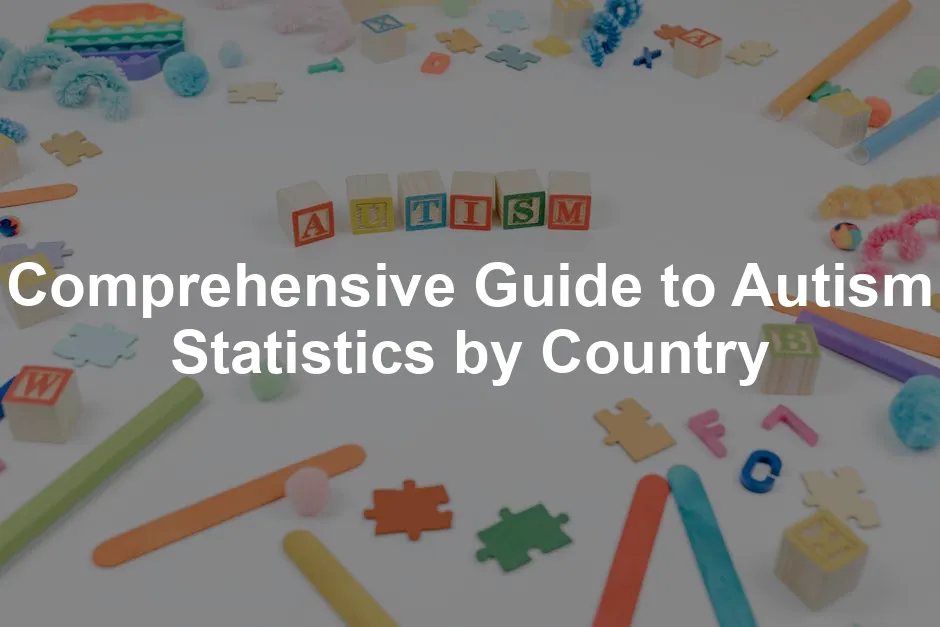Introduction
Autism Spectrum Disorder (ASD) affects millions globally. It’s a complex neurodevelopmental condition that impacts how individuals communicate and interact. The signs of autism often surface in early childhood, making timely diagnosis crucial.
Understanding autism statistics is essential for various reasons. First, it raises awareness about the challenges autistic individuals face. Second, it informs researchers and policymakers, guiding funding and resource allocation for support systems. Lastly, these statistics can help educators and healthcare providers deliver better services.
Over the last few decades, autism rates have skyrocketed. For instance, in the United States, the CDC reported a significant increase from 1 in 150 children in 2000 to 1 in 36 children in 2023. This surge reflects heightened awareness and improved diagnostic criteria rather than a genuine rise in cases. Countries worldwide are experiencing similar trends, underscoring the need for ongoing research and understanding.
As we navigate the complexities of autism statistics, it becomes clear that awareness and acceptance are vital. By fostering a deeper understanding of autism, we can create a more inclusive society for individuals on the spectrum and their families.

Understanding Autism
What is Autism?
Autism, or Autism Spectrum Disorder (ASD), is a lifelong condition that typically manifests in early childhood. It encompasses a range of conditions characterized by difficulties in social interaction, communication challenges, and repetitive behaviors. Individuals with autism may exhibit varying symptoms and abilities, making it a spectrum disorder.
Common traits of autism include:
- Social Interaction Difficulties: Maintaining eye contact, understanding nonverbal cues, and forming meaningful relationships can be particularly challenging.
- Communication Challenges: This may range from delayed language development to difficulties in understanding and using language effectively.
- Repetitive or Restrictive Behaviors: These can include repetitive movements or an intense preference for routine and sameness.
Each person with autism is unique, experiencing different combinations of these characteristics. While some individuals may require significant support, others may excel in specific areas or lead independent lives. Understanding these nuances is essential for providing appropriate support and resources.
Recognizing autism’s diverse nature helps us appreciate the individual strengths and challenges faced by those on the spectrum. By fostering awareness, we can create a more inclusive environment for everyone.
Looking for resources to understand autism better? Grab a copy of “Autism Spectrum Disorder: What Every Parent Needs to Know”. It’s packed with insights that will help you navigate this journey with confidence!

Historical Context
Understanding autism is a tale as old as time, or at least as old as the 20th century. Initially, autism was a mystery wrapped in an enigma. The term “autism” first emerged in 1943, thanks to Dr. Leo Kanner. He described a group of children showing unique behaviors, such as withdrawal from social interaction. Fast forward to 1944, when Hans Asperger coined a similar term, focusing on children who had social difficulties yet often excelled in specific areas.
In those early days, the understanding of autism was limited. Parents faced a dual challenge: grappling with their children’s behaviors and a society that often stigmatized differences. This stigma can still be felt today, but awareness has certainly evolved.
The Diagnostic and Statistical Manual of Mental Disorders (DSM) has undergone significant changes since its first edition was published in 1952. The DSM-5, released in 2013, consolidated previous categories into a single diagnosis known as Autism Spectrum Disorder (ASD). This change reflected a broader understanding of the autism spectrum, shifting from rigid categories to a more inclusive perspective, recognizing that autism exists on a continuum.
Similarly, the International Classification of Diseases (ICD) has kept pace. The ICD-11, implemented in 2022, aligned its definitions closely with the DSM-5. These updates allow for more accurate diagnoses, helping healthcare professionals identify autism more effectively across diverse populations.
As awareness has grown, so has the understanding of autism as a neurodevelopmental disorder rather than a behavioral issue. In the 1970s, the notion that autism resulted from poor parenting—specifically “refrigerator mothers”—was prevalent. Thankfully, this myth has been debunked. Today, we understand that autism is shaped by a complex interplay of genetic and environmental factors.
Societal perception has shifted dramatically as well. Once viewed as a rare condition, autism is now recognized as a common developmental disorder, with estimates suggesting that approximately 1 in 100 individuals are diagnosed globally. This increase is attributed to better diagnostic practices and increased awareness, rather than a true surge in cases.
In summary, the journey through autism’s history reveals significant milestones. From the early days of misunderstanding to current advances in diagnostic criteria, society’s view of autism has transformed. The increased awareness and acceptance continue to pave the way for better support systems and resources for individuals with autism and their families. The narrative is still unfolding, and with it, the hope for a more inclusive future.
Global Autism Statistics
When it comes to autism statistics, the numbers can feel like a riddle. Currently, global estimates suggest that about 1 in 100 individuals is diagnosed with autism. But hold onto your hats because the numbers vary widely across different countries and studies.
For instance, in the United States, the Centers for Disease Control and Prevention (CDC) reports that approximately 1 in 36 children are diagnosed with autism, a figure that has skyrocketed from 1 in 150 in 2000. This dramatic rise isn’t just an American phenomenon; similar trends appear in other developed nations. South Korea is a prime example, where studies indicate a prevalence of about 1 in 38 children.
However, not all countries report such high rates. In France, for instance, the prevalence stands at about 69.3 cases per 10,000 individuals, which translates to roughly 1 in 144 people. It’s crucial to note that these variations often stem from differences in diagnostic practices, cultural attitudes, and the availability of resources.
Several factors contribute to the discrepancies in reported rates. One significant factor is the level of awareness about autism within a country. In nations with higher awareness and better access to diagnostic services, autism is more likely to be identified. Conversely, in countries where autism is less understood or stigmatized, the rates may appear lower simply due to underdiagnosis.
Moreover, the methodologies used in studies can lead to varying outcomes. Some studies rely on parent-reported data, while others utilize healthcare records or community screenings. These different approaches can yield contrasting results, further complicating the global picture.
Cultural beliefs also play a substantial role in how autism is perceived and reported. In some societies, behaviors associated with autism may be normalized or overlooked, leading to lower reported rates. In contrast, in more diagnostic-rich environments, children exhibiting even mild symptoms may receive an autism diagnosis.
As we look to the future, understanding the nuances behind these statistics is vital. Continued research and advocacy will help bridge the gaps in knowledge and ensure that individuals with autism receive the support they need, no matter where they are in the world. The journey of understanding autism is ongoing, and each statistic tells a story worth exploring.
For parents looking for engaging ways to help their children understand autism, consider checking out “The Curious Incident of the Dog in the Night-Time”. This book offers a unique perspective that can open discussions about autism and help foster understanding.

Countries with the Highest Autism Rates
When it comes to autism rates, the numbers can be shocking! Understanding these statistics is vital for awareness and improved services. Here’s a look at some countries leading the pack in reported autism prevalence.
Top 10 Countries
- United States: The CDC reveals a notable rate of 1 in 36 children diagnosed with autism. This number has seen a dramatic rise over the years, reflecting increased awareness and better diagnostic practices.
- South Korea: Nearly neck-and-neck with the U.S., South Korea reports a prevalence of 1 in 38 children. The emphasis on early diagnosis and intervention likely contributes to this high rate.
- United Kingdom: The UK follows with a rate of 1 in 64 children. Here, the National Health Service has worked hard to raise awareness and improve diagnostic pathways.
- Japan: Coming in at 1 in 87 children, Japan’s statistics reflect a growing understanding of autism. Cultural factors may influence how autism is perceived and diagnosed.
- Canada: In Canada, approximately 1 in 66 children are diagnosed with autism, showcasing the country’s commitment to autism awareness and supportive services.
- Australia: Australia’s rate is around 1 in 70 children, with a robust support system for individuals on the spectrum.
- Denmark: Denmark reports a prevalence of 1 in 100 children. The country’s healthcare system emphasizes early intervention and supportive education.
- France: Although France has a lower reported prevalence, around 1 in 144 individuals, this highlights the need for better diagnostic practices.
- Germany: In Germany, the prevalence is about 1 in 160 children, with ongoing research aimed at understanding and supporting those with autism.
- India: A staggering 1 in 500 children are diagnosed in India, but this number may not reflect the true prevalence due to underdiagnosis and lack of resources.

Data Sources and Methodologies
These statistics stem from various studies, including national health records, surveys, and community screenings. The methodologies used can significantly impact reported rates. For example, some countries focus on parent-reported data, while others rely on clinical evaluations.
Furthermore, cultural attitudes towards autism play a crucial role. In nations with heightened awareness, cases are more likely to be identified. Conversely, in cultures where stigma surrounds mental health, individuals may go undiagnosed.
The reliability of these statistics also hinges on access to healthcare and education. Countries with robust healthcare systems tend to report higher prevalence rates, not necessarily indicating a true increase in autism cases but rather improved identification.
In summary, these numbers tell a story of both progress and challenges. Increased awareness and better diagnostic practices are vital to ensuring that individuals with autism receive the support they need. Understanding these statistics is the first step toward fostering a more inclusive world for everyone.
If you want to explore more about autism and its implications, check out “NeuroTribes: The Legacy of Autism and the Future of Neurodiversity”. This book offers a thoughtful exploration of autism’s history and its impact on society.

Factors Influencing Autism Rates
Diagnostic Practices
When it comes to autism diagnosis, one size definitely does not fit all. Countries vary in how they define and identify autism spectrum disorder (ASD). Diagnostic criteria can change based on the latest research, cultural norms, and even public awareness. For instance, the DSM-5 in the U.S. emphasizes social communication deficits and restricted behaviors as core symptoms. Meanwhile, the ICD-11 used in Europe offers similar but slightly different criteria. This variation can lead to differences in reported autism rates across the globe.
Cultural perceptions also play a significant role in recognizing autism. In some cultures, behaviors associated with autism might be viewed through a lens of stigma or misunderstanding. Consequently, families may avoid seeking a diagnosis, leading to underreporting. In contrast, countries with higher awareness and support systems are more likely to encourage families to pursue evaluations, resulting in more diagnosed cases.
Access to healthcare is another crucial factor. Countries with robust healthcare systems often have better resources for autism evaluation and intervention. This includes trained professionals who can accurately diagnose ASD. Conversely, nations with limited healthcare access might struggle to identify autism effectively, contributing to lower reported rates. For instance, in some developing countries, the lack of trained practitioners means many children with autism remain undiagnosed and unsupported.
Furthermore, the availability of resources, such as educational programs and therapy, significantly impacts diagnosis and support. In regions where these resources are scarce, families may not recognize the signs of autism or might not pursue a diagnosis due to financial constraints. This gap in access can lead to discrepancies in the reported prevalence of autism.
Ultimately, understanding the various diagnostic practices, cultural perceptions, and healthcare access levels is essential for interpreting autism statistics. These factors intertwine to create a complex landscape that influences how autism is recognized and reported across different nations.
For children who might benefit from engaging activities, consider sensory toys such as sensory toys for autism. These toys can help with focus and provide calming effects for children who may feel overwhelmed.

Environmental and Genetic Factors
As we look at autism rates, environmental and genetic factors emerge as key players. Research suggests a mix of both influences contributes to the prevalence of autism worldwide. First off, environmental factors can include prenatal exposures, such as maternal infections, exposure to certain chemicals, or complications during pregnancy. For instance, studies have hinted that maternal diabetes or advanced parental age may elevate the risk of autism in children.
Genetics also plays a significant role. If you have one child with autism, the likelihood of a second child being diagnosed increases. Genetic predispositions can run deep, and researchers are still uncovering the myriad ways genes interact with environmental factors. This interplay is complex, and while the exact mechanisms are not fully understood, the evidence suggests that genetics is a crucial piece of the puzzle.
Socioeconomic status can further complicate the picture. Families with higher incomes often have better access to healthcare, diagnostic services, and educational resources. This access allows for earlier detection and intervention, which can lead to higher reported rates of autism in affluent regions. On the other hand, lower-income families might face barriers that prevent them from seeking a diagnosis or receiving support, resulting in lower reported prevalence rates.
Moreover, awareness of autism varies widely across different cultures. In places where autism is well understood and accepted, families are more likely to seek help. In contrast, in societies where autism is stigmatized or misunderstood, families might avoid diagnosis altogether, further skewing statistics.
In summary, a combination of environmental influences, genetic factors, and socioeconomic conditions shapes the landscape of autism prevalence around the world. Understanding these elements is vital for addressing the needs of individuals on the spectrum and ensuring that all families have access to the support and resources they require.

Challenges in Measuring Autism Statistics
Measuring autism statistics is like trying to catch smoke with your bare hands—it’s tricky! One major hurdle is the lack of standardized diagnostic criteria across countries. Each nation may have different methods for identifying autism, leading to inconsistencies in reporting. This makes comparing data a real brain-teaser.
Many countries face significant challenges in conducting autism assessments. Limited healthcare resources can hinder the ability to evaluate and track cases effectively. Some nations simply lack the infrastructure to conduct comprehensive assessments, leading to underreporting. A country with fewer trained professionals is less likely to identify individuals on the spectrum, resulting in skewed statistics.
Stigma and cultural beliefs also play a hefty role in underreporting autism cases. In some cultures, differences in behavior may be viewed as taboo or misunderstood. Families might hesitate to seek a diagnosis, fearing social repercussions or discrimination. This reluctance can lead to an invisible population of individuals with autism, further complicating the picture.
Moreover, the perception of autism varies widely across different societies. In cultures where mental health issues are stigmatized, families may avoid pursuing diagnoses entirely. This can create a false sense of security regarding the prevalence of autism. The result? A global statistic that might not accurately reflect the reality on the ground.
To add another layer, the methodologies used to gather data differ significantly. Some studies rely on parent-reported data, while others depend on healthcare records. These varying approaches can lead to discrepancies in reported rates. For instance, a country with a robust healthcare system might report higher autism rates simply because they have the means to identify more cases.
Additionally, the language used in diagnostic criteria can influence the identification process. Different terms in various languages may not capture the full spectrum of autism. This can lead to misunderstandings about the condition and its symptoms, contributing to the challenges of accurate reporting.
In summary, measuring autism statistics is fraught with complexities. From varied diagnostic criteria to cultural stigmas, numerous factors can lead to underreporting and misinterpretation. As we strive for a clearer understanding of autism prevalence globally, addressing these challenges is crucial. Only then can we hope to develop effective policies and support systems for individuals on the spectrum.
For those looking to support individuals with autism, consider investing in weighted blankets for anxiety relief. These can provide a calming effect and help with sensory processing.

Autism Awareness and Advocacy
Global Initiatives
In recent years, international efforts have surged to raise autism awareness and improve diagnosis worldwide. Organizations like Autism Speaks and the World Health Organization (WHO) are at the forefront of this movement. Their campaigns aim to educate communities about autism spectrum disorder (ASD) while advocating for better access to diagnostic services.
One noteworthy initiative is World Autism Awareness Day, celebrated on April 2nd each year. This day brings together advocacy groups, healthcare providers, and families to promote understanding and acceptance of autism. Through various activities and events, participants raise awareness and support for individuals with autism and their families. This global focus encourages nations to prioritize autism in public health agendas.
Moreover, local organizations play a critical role in advocating for better resources and support systems. For instance, in countries like South Korea and Japan, grassroots movements have emerged to push for better educational opportunities and healthcare access for individuals with autism. These community-driven efforts can lead to meaningful change, as they often resonate deeply with local populations.
The importance of advocacy cannot be overstated. Improved resources can lead directly to better support for individuals on the spectrum. Access to therapy, educational programs, and community resources can significantly enhance the quality of life for those affected by autism. Without advocacy, many would remain unheard and unsupported, perpetuating the cycle of misunderstanding.
Several organizations are working tirelessly to support individuals with autism. For example, the Autism Society of America offers resources, information, and grants to families in need. Their efforts highlight the significance of tailored support systems that can adapt to local contexts and needs.
In conclusion, global initiatives and advocacy efforts are instrumental in raising awareness and promoting better resources for individuals with autism. This collective push encourages communities to embrace inclusion, ultimately leading to a more supportive environment for those on the spectrum. Together, we can create a world where everyone has the opportunity to thrive.
Looking for ways to engage creatively with your child? Explore therapeutic art supplies. They can be a fantastic way for children to express themselves and process their emotions.

Conclusion
Understanding autism statistics is vital for addressing the needs of individuals on the spectrum. These numbers illuminate the challenges faced by those affected and highlight the need for effective policies and support systems. Continued research and advocacy are essential to ensure that everyone, regardless of where they live, has access to the resources they need.
As we strive to improve our understanding of autism, it’s crucial to recognize the importance of accurate data collection and reporting. By prioritizing research and awareness, we can foster a more inclusive society that values the contributions of individuals with autism.
So, let’s commit to advocating for better resources, promoting awareness, and supporting ongoing research. Together, we can pave the way for a brighter future for individuals on the spectrum and their families. The journey may be challenging, but with determination and collaboration, we can make significant strides toward understanding and supporting autism.
For those interested in mindfulness practices, consider books on mindfulness for kids. These can help foster emotional regulation and provide tools for coping with anxiety.

FAQs
What is autism spectrum disorder?
Autism spectrum disorder (ASD) is a neurodevelopmental condition characterized by challenges in social interaction, communication, and repetitive behaviors. Symptoms can vary widely among individuals.
Why are autism rates increasing?
Several factors contribute to rising autism rates, including increased awareness, improved diagnostic criteria, and better access to healthcare services. This trend reflects a growing recognition rather than a true surge in cases.
Are there countries with no reported autism cases?
No country is entirely free from autism; however, some nations report lower prevalence rates. This often reflects cultural attitudes and limited resources for diagnosis rather than an actual absence of cases.
How can awareness be improved?
Improving awareness involves education, advocacy, and community engagement. Hosting events, sharing information, and promoting understanding can help create a more inclusive environment for individuals with autism.
Please let us know what you think about our content by leaving a comment down below!
Thank you for reading till here 🙂
All images from Pexels




